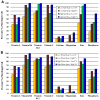Food group intake and micronutrient adequacy in adolescent girls
- PMID: 23201841
- PMCID: PMC3509514
- DOI: 10.3390/nu4111692
Food group intake and micronutrient adequacy in adolescent girls
Abstract
This study explores the contribution of food group intakes to micronutrient adequacy among 2379 girls in the National Growth and Health Study during three age periods (9-13, 14-18, and 19-20 years). Data on food and nutrient intakes from 3-day diet records over 10 years were used to estimate mean intakes and percent meeting Dietary Guidelines (DGA) recommendations for food intakes and Institute of Medicine's recommendations for vitamins and minerals. More than 90% of girls failed to consume the recommended amounts of fruit, vegetables and dairy; 75% consumed less than the recommended amounts in the "meat" group. The vast majority of girls of all ages had inadequate intakes of calcium, magnesium, potassium, and vitamins D and E. In contrast, they consumed >750 kcal/day (~40% of total energy) from the DGA category of solid fat and added sugars, about five times the recommended maximum intakes. This study shows the importance of consuming a variety of foods in all five food groups, including those that are more energy dense such as dairy and meats, in order to meet a broad range of nutrient guidelines. Diet patterns that combined intakes across food groups led to greater improvements in overall nutritional adequacy.
Figures


Similar articles
-
Nutritional intakes in community-dwelling older Japanese adults: high intakes of energy and protein based on high consumption of fish, vegetables and fruits provide sufficient micronutrients.J Nutr Sci Vitaminol (Tokyo). 2004 Jun;50(3):184-95. doi: 10.3177/jnsv.50.184. J Nutr Sci Vitaminol (Tokyo). 2004. PMID: 15386931
-
Food group and micronutrient intake adequacy among children, adults and elderly women in Greece.Nutrients. 2015 Mar 11;7(3):1841-58. doi: 10.3390/nu7031841. Nutrients. 2015. PMID: 25768954 Free PMC article.
-
Consuming the daily recommended amounts of dairy products would reduce the prevalence of inadequate micronutrient intakes in the United States: diet modeling study based on NHANES 2007-2010.Nutr J. 2015 Sep 4;14:90. doi: 10.1186/s12937-015-0057-5. Nutr J. 2015. PMID: 26337916 Free PMC article.
-
How may a shift towards a more sustainable food consumption pattern affect nutrient intakes of Dutch children?Public Health Nutr. 2015 Sep;18(13):2468-78. doi: 10.1017/S1368980015002426. Public Health Nutr. 2015. PMID: 26344035 Free PMC article. Review.
-
Optimal growth and development: are teenagers getting enough micronutrients from their diet?Proc Nutr Soc. 2024 Dec;83(4):245-253. doi: 10.1017/S002966512400017X. Epub 2024 Mar 4. Proc Nutr Soc. 2024. PMID: 38433580 Review.
Cited by
-
Added Sugars and Cardiovascular Disease Risk in Children: A Scientific Statement From the American Heart Association.Circulation. 2017 May 9;135(19):e1017-e1034. doi: 10.1161/CIR.0000000000000439. Epub 2016 Aug 22. Circulation. 2017. PMID: 27550974 Free PMC article. Review.
-
The relationship between micronutrient status and sleep patterns: a systematic review.Public Health Nutr. 2017 Mar;20(4):687-701. doi: 10.1017/S1368980016002603. Epub 2016 Oct 5. Public Health Nutr. 2017. PMID: 27702409 Free PMC article.
-
Prevalence and predictors of metabolically healthy obesity in adolescents: findings from the national "Jeeluna" study in Saudi-Arabia.BMC Pediatr. 2018 Aug 23;18(1):281. doi: 10.1186/s12887-018-1247-z. BMC Pediatr. 2018. PMID: 30139344 Free PMC article.
-
Milk beverages can reduce nutrient inadequacy among Brazilian pre-school children: a dietary modelling study.BMC Nutr. 2022 Nov 1;8(1):121. doi: 10.1186/s40795-022-00620-w. BMC Nutr. 2022. PMID: 36316737 Free PMC article.
-
Association of Added Sugars Intake with Micronutrient Adequacy in US Children and Adolescents: NHANES 2009-2014.Curr Dev Nutr. 2019 Nov 7;3(12):nzz126. doi: 10.1093/cdn/nzz126. eCollection 2019 Dec. Curr Dev Nutr. 2019. PMID: 32154496 Free PMC article.
References
-
- Committee on Use of Dietary Reference Intakes in Nutrition Labeling. Dietary Reference Intakes: Guiding Principles for Nutrition Labeling and Fortification. The National Academies Press; Washington, DC, USA: 2003. - PubMed
-
- U.S. Department of Health and Human Services and U.S. Department of Agriculture. The Report of the Dietary Guidelines Advisory Committee on Dietary Guidelines for Americans. USDA Agricultural Research Service; Washington, DC, USA: 2005.
Publication types
MeSH terms
Substances
Grants and funding
LinkOut - more resources
Full Text Sources

